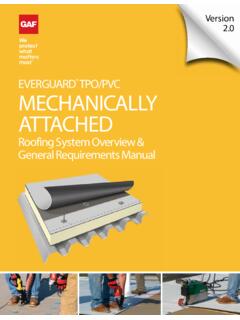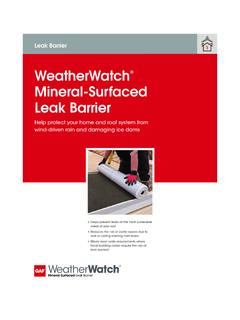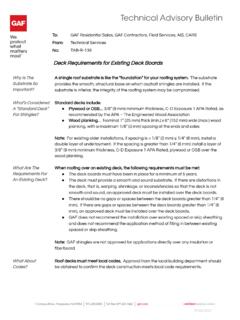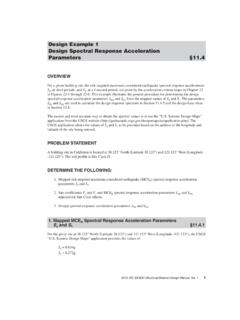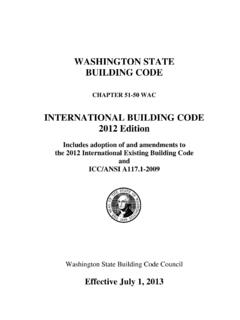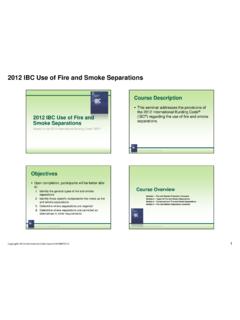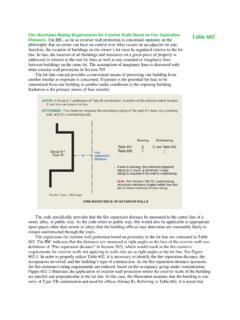Transcription of UL Evaluation Report - GAF
1 UL Evaluation Report UL ER21-01 Issued: February 20, 2019 Revised: October 2, 2019 Visit UL s Product iQ database for current status of Report . UL Category Code: ULEZ CSI MasterFormat DIVISION: 07 00 00 THERMAL AND MOISTURE PROTECTION Sub-level 2: 07 30 00 Steep Slope Roofing Sub-level 3: 07 31 00 Shingles and Shakes Sub-level 4: 07 31 13 Asphalt Shingle COMPANY: GAF 1 Campus Drive Parsippany, NJ 07054 (800) 766-3411 1. SUBJECT: Asphalt Shingles Timberline HDZ , Timberline AH, Timberline CS 2. SCOPE OF Evaluation 2018, 2015, 2012 , 2009, and 2006 International Building Code (IBC) 2018, 2015, 2012 , 2009, and 2006 International Residential Code (IRC) ICC ES Acceptance Criteria for Quality Documentation (AC10), Dated January 2019 The products were evaluated for the following properties: Exterior Fire Exposure (ANSI/UL790, ASTM E108) Wind Resistance (ASTM D3161; ASTM D7158) Physical Properties (ASTM D3462) Page 2 of 10 3.
2 REFERENCED DOCUMENTS ANSI/UL790 (ASTM E108), Standard Test Methods for Fire Tests of Roof Coverings, Eighth Edition, with revisions through October 19, 2018 ASTM D3161-16a, Standard Test Method for Wind-Resistance of Asphalt Shingles (Fan-Induced Method) ASTM D7158-17, Standard Test Method for Wind Resistance of Asphalt Shingles (Uplift Force/Uplift Resistance ASTM D3462-16, Standard Specification for Asphalt Shingles Made from Glass Felt and Surfaced with Mineral Granules ICC ES Acceptance Criteria for Quality Documentation (AC10), Dated January 2019 4. USES GAF asphalt shingles are used as roof coverings for new and existing roofs. 5. PRODUCT DESCRIPTION GAF asphalt shingles are roof covering materials complying with the following properties when installed as described in this Report .)
3 The products are laminated shingles and are available in metric sizes. Fire Classification: GAF asphalt shingles covered under this Report have been tested for fire classification Class A in accordance with UL 790 (ASTM E108). Shingles tested in accordance with UL790 (ASTM E108) qualify for use under Section of the 2018, 2015, 2012 , 2009 and 2006 IBC and Section of the 2018, 2015, 2012 , 2009 and 2006 IRC. Wind Resistance: GAF asphalt shingles covered under this Report have been tested for wind resistance in accordance with ASTM D3161 and ASTM D7158. Shingles tested in accordance with ASTM D3161 are classified as Class F and qualify for use under Section of 2018, 2015 IBC, Section of the 2012 , 2009 and Section of 2006 IBC, or the exception to Section of the 2018, 2015, 2012 , 2009 and 2006 IRC.
4 Shingles tested in accordance with ASTM D7158 are classified as Class H and qualify for use under Section of 2018, 2015 IBC in locations as shown in Table 1, Section of the 2012 and 2009 IBC in locations as shown in Table (1) or under Section of the 2018, 2015, 2012 and 2009 IRC in locations as shown in Table , where the maximum basic wind speed is 150 mph (67 m/s) or less with exposure category of B or C (ASCE 7) and a maximum building height of 60 feet ( m). Installation must be in accordance with Section of the 2018 IBC, Section of the 2015, 2012 , 2009 and 2006 IBC or Section of the 2018, 2015, 2012 , 2009 and 2006 IRC, as applicable.
5 Physical Properties: GAF asphalt shingles covered under this Report have been tested for physical properties in accordance with ASTM D3462. Shingles tested in accordance with ASTM D3462 qualify for use under Section of the 2018 IBC, Section of 2015, 2012 , 2009 and 2006 IBC or Section of the 2018, 2015, 2012 , 2009 and 2006 IRC. When installed on new construction in accordance with this Report and the GAF installation instructions, the shingles are a Class A roof covering. When the shingles are installed over existing roof coverings, the Class A fire classification is maintained. Page 3 of 10 Laminated Shingles Timberline HDZ , Timberline AH, Timberline CS: Timberline HDZ , Timberline AH and Timberline CS are laminated shingles manufactured with a double layer of fiberglass mats coated with asphalt on all sides, and surfaced on the weather-exposed side with mineral granules.
6 See Table 2 for product dimensions and manufacturing location. 6. INSTALLATION GAF asphalt shingles must be installed in accordance with the applicable code, this Report and the manufacturer s published installation instructions. The shingles must be installed in accordance with Section of the 2018, 2015, 2012 , 2009 and 2006 IBC or Section of the 2018, 2015, 2012 , 2009 and 2006 IRC, as applicable, except as noted in this Report . The manufacturer s published installation instructions must be available at all times on the jobsite during installation. Minimum roof slopes must be 2:12 ( slope) for the laminated shingles described in Section of this Report . Underlayment and Ice Barriers: For roof slopes greater than 4:12, the roof deck must be covered with a minimum of one layer of underlayment as described in Sections and of this Report .
7 For roof slopes between 2:12 and 4:12, two layers of the underlayment described in Section or one layer of the self-adhering polymer modified bitumen sheet in Section of this Report are required. Underlayment application and installation must be in accordance with Section and Tables (2) and (3) of the 2018 IBC, Section of the 2015, 2012 , 2009 and 2006 IBC or Section and Tables (2) and (3) of the 2018, 2015 IRC, Section of the 2012 , 2009 and 2006 IRC, as applicable. In areas where there has been a history of ice forming along the eaves, causing a backup of water, an ice barrier must be provided in accordance with Section of the 2018 IBC, Section of the 2015, 2012 , 2009 and 2006 IBC or Section of the 2018, 2015 IBC, Section of the 2012 , 2009 and 2006 IRC, as applicable.
8 Starter Shingle: A starter course, as described in Section of this Report , must be attached to the eave edge using fasteners described in Section of this Report , located 3 to 4 inches (76 to 102 mm) from the eave edge and spaced 1 inch ( mm) and 12 inches (305 mm) from each end, for a total of four fasteners per shingle. The starter strip must overhang the eave and rake edges by 1/4 to 3/8 inch ( to mm). Asphalt Shingles: The first course of field shingles must be installed over the starter course described in Section of this Report . Page 4 of 10 Shingles must be installed with vertical joints offset a minimum of 4 inches (102 mm) from adjacent courses. Laminated Shingles Timberline HDZ , Timberline AH, Timberline CS: For roof slopes of 2:12 up to 21:12 ( to 175% slope), each shingle must be fastened to the roof deck using a minimum of four fasteners, spaced as shown in Table 2.
9 For roof slopes over 21:12 (175% slope), six fasteners must be used, spaced as shown in Table 2. Fasteners must be located 5-13/16 - 7-5/8 inches (148 - 194 mm) above the butt edge of the shingles. Maximum exposure to the weather must be 5-5/8 inches (143 mm). In colder climates or wind regions where it is questionable whether the thermal-sealing adhesive will activate to seal the shingles, the shingles can be hand-sealed. Four 1-inch diameter (25 mm) spots of cement should be placed under the exposed portion of the shingle 1-inch (25 mm) and 13-inch (330 mm) in from each side and 1-inch (25 mm) up from bottom of the shingle. Valley Construction and Other Flashing: Valleys must consist of woven, open valley or closed-cut construction and must be flashed in accordance with Section of the 2018 IBC, Section of the 2015, 2012 , 2009 and 2006 IBC or Section of the 2018, 2015, 2012 , 2009 and 2006 IRC.
10 Other flashings must be in accordance with Sections and of the 2018 IBC, Sections and of the 2015, 2012 , 2009 and 2006 IBC, or Sections and of the 2018, 2015, 2012 , 2009 and 2006 IRC, as applicable. Hip and Ridge Application: Hip and ridge shingles must be placed evenly over hips and ridges, starting at the bottom of the hip or from the end of the ridge opposite the direction of the prevailing wind. Field-cut three-tab shingles must be fastened to the roof deck using two fasteners, one located on either side of the shingle, 5-1/2 inches (140 mm) from the exposed end, and 1 inch ( mm) in from the edge. Prefabricated hip and ridge shingles must be installed with minimum two fasteners in accordance with the manufacturer s installation instructions.

